The Realized Visions of Six Master Gardeners
By Maxine Carter-Lome
Gardens can be a source of food, inspiration, experimentation and personal pride, all key elements behind some of the greatest historic house gardens in America, six of which are profiled here. Although all six gardens are different in terms of design, layout, scale and horticultural heritage, they’ve all been cultivated in the vision of their founding gardener, be they a Founding Father, Industrialists, Master Gardener or horticultural enthusiast.
Longwood Gardens
Kennett Square, Pennsylvania
www.longwoodgardens.org
“When visiting Longwood Gardens, you are immersed not only in the breathtaking surroundings but in a rich history as well. The traditions and elegance of the gardens have evolved over decades to create the magnificence we have today.”
Considered one of the world’s great gardens, Longwood is the living expression of American entrepreneur and businessman Pierre S. du Pont’s (1870-1954) vision.
The oldest building at Longwood Gardens, a two-story brick farmhouse, was built in 1730 by Joshua Pierce. Joshua’s descendants actively pursued an interest in natural history and began planting an arboretum that eventually covered 15 acres. The collection included specimens from up and down the Eastern seaboard and overseas. By 1850, the arboretum boasted one of the finest collections of trees in the nation and had become a place for the locals to gather outdoors – a new concept that was sweeping America at the time.
As the 19th century rolled into the 20th, the heirs to the land lost interest in property, and allowed the arboretum to deteriorate. The property passed through several hands until it was purchased in 1906 by Pierre S. du Pont who purchased the house and property as his summer home and weekend residence. Within a few years, his desire to make it a place where he could entertain his friends transformed a simple country farm into one of the country’s leading horticultural display gardens.
Pierre broke ground on his vision by adding a 600-foot long Flower Garden Walk in 1907. The Flower Garden Walk features a pool known as the Round Fountain at the intersection of the main paths. Its simple jet of water was Longwood’s first fountain. He chose to fill his new garden not with the usual jungle of exotic tropical foliage as was then the fashion but rather with fruits and flowers used in a decorative, horticultural way.
In 1916 Pierre constructed a stunning Conservatory “designed to exploit the sentiments and ideas associated with plants and flowers in a large way.” One observer termed his greenhouses “floral sun parlors.” In 1928, Pierre embarked on what would be his last and most ambitious project to date – creating a 5-acre Main Fountain Garden directly south of the Conservatory. The Main Fountain Garden “combines Italianate ornamentation and French grandeur with World’s Fair showmanship. Like other great fountains, it is an engineering tour de force using the latest technology of the time.” The Main Fountain Garden debuted to the public in 1931 and was the last major project in the Gardens during Pierre’s life.
To manage his estate’s gardens, Pierre employed a Horticultural Department of 29, including eight gardeners to oversee the perpetual indoor flower show, aided by three boiler operators, and 11 outdoor gardeners and groundskeepers.
Today the 1,077-acre Longwood Gardens consists of varied outdoor gardens, ranging from formal to naturalistic in their landscape design, and 20 indoor gardens within a 4.5 acre (1.8 hectares) group of heated greenhouses. Longwood’s Conservatory contains 4,600 different types of plants and trees, as well as fountains; its plant collection includes well over 9,000 taxa or species and varieties. It is, as guests say, “a place beyond compare.”
The Griswold Museum
Olde Lyme, Connecticut
https://florencegriswoldmuseum.org
“Miss. Florence endeavored to infuse the air of yesteryear through the medium of good old-fashioned flowers.” – Journalist H.S. Adams, 1914
During the early years of the 20th century, the Lyme Art Colony in Old Lyme, Connecticut was America’s most famous summer art colony. At the center of this movement was Miss Florence Griswold’s home and gardens. For Miss. Florence and the artists staying at her home, her garden was a space for creative expression, both for her as a gardener, and for the artists who taught and painted there “en plein air.”
The Griswold Family home, today site of the Florence Griswold Museum, was a late Georgian-style mansion built in 1817 on a twelve-acre estate. With the family’s reversal of fortune after the Civil War, the family turned their home into a school and eventually, with only Miss. Florence left at home, a boarding house.
Prominent landscape painter Henry Ward Ranger (1858-1916), having recently returned from Europe, saw in Old Lyme an ideal setting for establishing a new American school of landscape painting. He found in Miss Florence’s home and hospitality the perfect place to settle. Other artists were invited by Ranger, including Childe Hassam and William Chadwick, and the home of American Impressionism was born.
Florence Griswold was a keen gardener. She was constantly in search of new and unusual plants as added inspiration for the artists and her own delight as a gardener. Found among her correspondence were seed catalogues and references to gardening books. Her home was known to be filled with small, informally arranged bouquets of fresh flowers picked from her garden.
Miss Florence’s garden can be characterized by what is referred to today as a “grandmother’s garden,” in which masses of flowers were informally arranged in bordered beds close to the house and filled with old-fashioned blooms such as hollyhock, iris, foxglove, heliotrope, phlox, cranesbill, daylilies, and other perennials. These gardens were designed at a time when the Garden Movement—a philosophy that proposed the hobby of gardening could provide beauty and balance within this fast-changing world—encouraged gardeners to personalize their garden beds with color and diversity. Many of the artists at Miss. Florence’s home regularly tended the garden, with some having their own patch near their studios on the property to grow those plants they loved to paint. Artists’ gardens were considered their personal laboratories for Impressionist studies of light and color.
After her death in 1937, the garden fell into disrepair. In 1998 an archaeological dig of the site helped to identify the physical boundaries of the garden beds and walkways as well as the surrounding orchard and outbuildings. With the help of paintings and photographs, the garden has been restored to how it looked in 1910.
In addition to the role it played in inspiring artists during the rise of the American Impressionist Movement, the revived gardens at the Florence Griswold Museum continue to welcome artists and admirers each year to paint and reflect among garden scenes full of beautiful flowers and greenery.
Hyde Park
Hyde Park, NY
www.nps.gov/hofr
“All that is within me cries out to go back to my home on the Hudson River” – Franklin Delano Roosevelt
Springwood on the Hudson River in Hyde Park, NY was the birthplace, lifelong home, and burial place of the 32nd President of the United States, Franklin Delano Roosevelt. Today, “Hyde Park” is the Home of Franklin D. Roosevelt National Historic Site.
While the early history of the house on the Springwood estate remains unclear, it is believed that the oldest part of the large farmhouse was constructed c1800. James Roosevelt, Franklin D. Roosevelt’s father, purchased the estate in 1866 and it was in the house that FDR was born and raised, and remained after his marriage to Eleanor in 1905 to stay close to his over-protective mother, Sara, who owned the house until her death in 1941.
Franklin called Springwood “The Center of The World,” and in many ways it was. During his presidency FDR returned to his family home, dubbed the “Summer White House,” two hundred times, hosting political associates as well as other prominent national and international figure. In 1939 FDR hosted King George VI and Queen at Springwood (the first time a reigning monarch of England had visited the United States), feeding them hotdogs at a picnic on the forested grounds.
Large home gardens were typical features of the diverse, self-sustaining Hudson River estate farms, and Springwood was no exception. The Roosevelts’ vegetable garden (called the Home Garden) was a central part of life for the family. FDR grew up playing in the garden and enjoying its bounty at the dinner table. His children and grandchildren helped work in the garden, pulling weeds and harvesting. Many say FDR’s memories of the garden helped shape his values as well as inform the environmental, agricultural, and social ideals that he fostered in the programs of his Presidency.
The landscape of Springwood displayed a simple elegance in contrast to the highly designed estates such as the Vanderbilt Mansion down the road. Roosevelt preferred the natural look of trees and undertook major forestry and conservation efforts throughout the property. He was quite proud of his efforts as a tree farmer, soliciting the expertise of professional foresters to help him manage his land and experiment with tree plantings with both environmental and economic potential. In total, FDR had more than 500,000 trees planted on the estate in plantations and orchards, and as ornamental specimens.
Roosevelt made his last visit to Springwood in the last week of March 1945, about two weeks before his death. At his own wish, he was buried in his mother’s Rose Garden. Eleanor is buried at his side along with their famous Scottish terrier Fala, and Chief, a German shepherd also owned by FDR. Soon after FDR’s death, the Roosevelt Home opened to the public and the garden was paved over to provide parking for visitors. Today, the National Park Service is restoring the Roosevelt Home Garden and establishing a Victory Garden Education program for park visitors and youth around the country.
Middleton Place
Charleston, South Carolina
www.middletonplace.org
“Middleton Place offers a supreme example of how a great garden created two centuries ago has grown to mellow maturity … a garden in America as fine as any you could find in Europe.” – Peter Coats, Great Gardens of the Western World, 1963.
Middleton Place in Charleston, SC was home to two of America’s Founding Fathers, Henry Middleton (1717-1784), president of the First Continental Congress, and his son Arthur Middleton (1742-1787), a signer of the Declaration of Independence. It is also the home of America’s oldest landscaped gardens, hailed as “the most important and most interesting garden in America” by the Garden Club of America.
The home itself was built in 1705 and 1706 in the grace and grandeur that were the hallmarks of 18th and 19th century South Carolina rice planting society. When Henry married Mary Williams in 1741, the house, which at the time was owned by Mary’s father, John Williams, transferred to Henry as part of Mary’s dowry. That same year, Henry broke ground on his “noble” gardens, envisioned in the grand classic style of early 18th century European and English gardens. Perhaps with this visual representation of his wealth, Henry wished to show his English cousins that people in the American colonies could live as elegantly as those in the mother country.
Henry was a pioneer in American gardening. A garden as large as the one he conceived was, in itself, a bold venture unlike any other in America at that time. It was a garden landscaped with formal symmetry following the principles employed by the French landscape architect André Le Nôtre, the master of classical garden design who laid out the gardens at Vaux-le-Vicomte and the Palace of Versailles.
Henry used the east-west axis of his property as a base from which to triangulate his bold garden plan, integrating a variety of geometrical garden rooms and private spaces including an Octagonal Garden, Inner Gardens, and Secret Gardens. Great attention was paid to woods and water in the garden’s layout and design so as to create a pattern with a central, uninterrupted vista, first over parterres to a dividing pathway and continuing on over a geometric sheet of water, through a regularly planted woodland, and ending in a narrowing remote forest view. Walking paths, straight and triangulated, were cut through the woods. Allées had trees and shrubs trimmed to appear as green walls while partitioning off small galleries, green arbors, and bowling greens. There were ornamental canals designed with mathematical precision, sundials and statues placed at strategic viewpoints with expansive vistas. Grassy ramps were preferred to stairways—their gentle slopes and the soft, imperceptible transitions were more pleasing to the eye, and more comfortable for walking.
And there were surprises at every turn. The gardens are enhanced by a spring-fed Reflection Pool, circular Rose Garden, Butterfly Lakes, and the Bosquet – a wilderness area that provides a transitional barrier between the natural and formal garden spaces. Magnificent statues only work to enhance the connection between man and nature.
Over the centuries, through the gardens’ natural evolution, Henry’s original plan has been strictly adhered to by his descendants. Henry would be pleased to see that the framework of his great 18th-century garden remains intact through stewardship and philanthropy.
Monticello
Charlottesville, Virginia
www.monticello.org
“No occupation is so delightful to me as the culture of the earth, and no culture comparable to that of the garden … But though an old man, I am but a young gardener.” – Thomas Jefferson to Charles W. Peale, August 20, 1811.
Thomas Jefferson is a man whose pen and footprints are all over the founding years of our country, but his home and gardens at Monticello were for him among his greatest accomplishments. With the first bricks laid in 1769 and up until his death in 1826 at home, Monticello was Jefferson’s autobiographical masterpiece.
The gardens at Monticello were a botanic showpiece, a source of food for the estate, and an experimental laboratory of ornamental and useful plants from around the world. Jefferson was known for his horticultural experiments and meticulous record-keeping, documenting nearly six decades of triumphs and failures in his Garden Book, a diary he maintained from 1766 to 1824. Open to new ideas from far-flung places, Jefferson collected seeds and incorporated gardening practices from European countries and such far away places as West Africa and Japan.
The flower gardens, in particular, were a family favorite. He created his final plan for the West Lawn in 1807, as he anticipated retiring from the presidency. A letter to granddaughter Anne Randolph contained his sketch and ideas, which called for oval beds at the corners of the house, and “a winding walk … with a narrow border of flowers on each side.” In 1807 and 1808 the oval beds and the serpentine walk were laid out. As the family and guests walked along the roundabout path, they could admire a vast array of flowers.
Corresponding with gardeners around the world, Jefferson collected hundreds of varieties, asking particularly for ones which were “handsome plants or fragrant.” Well represented among the flowers were bulbs such as tulips, perhaps because they were easily transported; and New World curiosities, including the Jeffersonia diphylla (twinleaf). Named in Jefferson’s honor in 1792, this delicate wildflower blooms around April 13, the date of its namesake’s birth.
Trees were an important part of Jefferson’s landscape design, and he planted more than 160 species at Monticello. Visitors were often given a tour of what one guest referred to as Jefferson’s “pet trees.”
The methodical Jefferson divided his 1,000-foot-long vegetable garden into twenty-four “squares,” or growing plots, arranged according to which part of the plant was harvested – whether “fruits,” “roots,” or “leaves.” Under Jefferson’s supervision, the garden also served as a kind of laboratory where he experimented with 330 varieties of more than seventy species of vegetables from around the world. Plants in the garden included squash and broccoli imported from Italy; beans and salsify collected by Lewis and Clark during their expedition; figs from France; and peppers from Mexico. Wrote Jefferson, “I am curious to select one or two of the best species or variety of every garden vegetable, and to reject all others.”
Jefferson’s gardens and collection of thousands of living horticultural specimens have been lovingly and painstakingly restored for the delight and education of guests to this designated World Heritage Site.
Winterthur Museum, Garden, and Library
Winterthur, Delaware
www.winterthur.org
“Color is the thing that really counts more than any other.” – Henry Francis du Pont, 1962
Henry Francis du Pont (1880-1969) had three life-long passions: gardening, breeding cattle, and collecting American antiques. Gardening was his first love, where he proudly bore the title of “Head Gardener” on his family’s estate home, Winterthur. Du Pont translated his love of the land into a unified work of art that embodies a romantic vision of nature’s beauty. Today it is one of the last of the original Wild Gardens.
“H.F.” developed an appreciation of nature as a boy that served as the basis for his life’s work in the garden. He selected the choicest plants from around the world to enhance the natural setting, arranging them in lyrical color combinations and carefully orchestrating a succession of bloom from late January to November, which he tracked in a weekly listing of what was in bloom – a tradition the Garden Division staff continue today.
Three generations of the du Pont family gardened at Winterthur. In 1839, Evelina du Pont and her husband moved into the house and named it after the Bidermann ancestral town of Winterthur, Switzerland. Before they named the estate, built the house or even sited the well, Evelina du Pont and her husband, Antoine Bidermann, the first generation of du Ponts to live at Winterthur, considered flowers. While in France in 1838, Evelina wrote her sister in Delaware: “Antoine … is getting a plan here for our House in which he has not forgotten the little Greenhouse, if such may be termed a little room for flowers.”
Evelina had more than a budding interest in flowers: they were her passion. The same can be said about all the subsequent owners of Winterthur, gardeners and flower arrangers all. Each generation built on the previous generation’s work, and all preferred a garden that made the most of the natural landscape.
At Winterthur, nearly one thousand acres of farmland surround the 60-acre garden which wraps around the house. The most formally landscaped and gardened areas are those closest to the house. As one moves farther away from the house, the tame, cultivated garden gives way to the freer Wild Garden style. The Wild Garden concept is built around the idea of gardening on a broad scale, “placing perfectly hardy exotic plants under a condition where they will thrive.” The paths are an integral part of the overall design, curved rather than straight, following the contours of the land, passing around trees, and drawing walkers into the garden.
In 1956, after he had gardened at Winterthur for seventy years, Henry Francis du Pont was awarded the Medal of Honor by the Garden Club of America, proclaiming him, “One of the best, even the best, gardener this country has ever produced.” The award cited du Pont as being a master of gardening, noting, “The woodland trees under planted with a profusion of native wildflowers and rhododendron, acre upon acre of dogwood, great banks of azaleas, lilies and peonies, iris and other rare specimens from many lands, each planted with taste and discrimination, each known, loved and watched, looking as though placed there by nature, forms one of the great gardens.”
Today, visitors can take a Garden Tram Tour or stroll through the 60-acre naturalistic Garden to experience the beauty that is H.F.’s living vision of a great American garden.


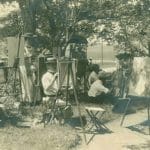
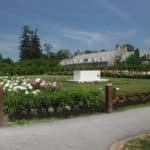
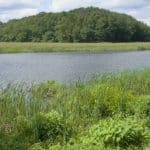
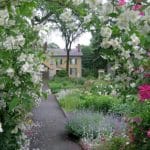

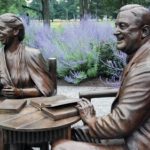
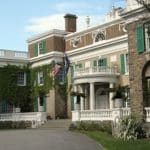
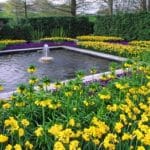



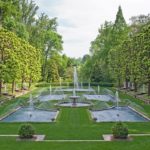
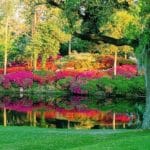
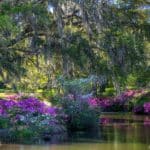

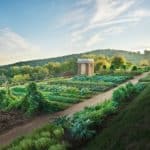
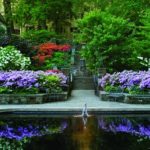
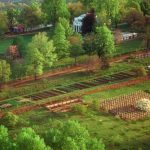
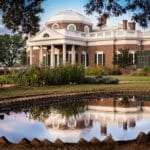


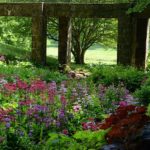



Related posts: